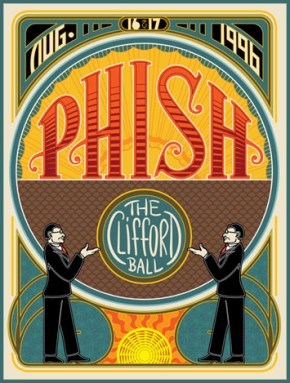Life on Mars?
| Originally Performed By | David Bowie |
| Original Album | Hunky Dory (1971) |
| Appears On |

|
| Music/Lyrics | Bowie |
| Vocals | Trey (verses); Page (chorus) |
| Historian | Martian Acaster (Doctor_Smarty) |
| Last Update | 2017-02-01 |
History
David Bowie released “Life on Mars?” in 1971, about the time the first successful NASA missions to explore the mysterious red planet were completed. The Mariner Missions, which lasted from 1964 to 1971, had found geomorphic evidence for the past existence of water on Mars. Water being a primary ingredient necessary to supporting the carbon-based life familiar to you humans, the possibility had been raised that life could have indeed at one time been present on Mars.
The song appeared on Hunky Dory, and was apparently intended as a parody of “My Way.” David Bowie had been asked to submit lyrics for a French melody named “Comme D’habitude.” His lyrics were rejected. Paul Anka was asked to submit an alternate set, and the Frank Sinatra signature piece (subsequently improved by Sid Vicious), was born. On Hunky Dory, Bowie did it his way.
David Bowie, “Life on Mars?”Phish first performed the song at the Will Rogers Auditorium, in Fort Worth, TX (10/13/95), while nearby NASA teams in Houston were making preparations for the Mars Global Surveyor mission. At Red Rocks on 8/6/96, the day before geologists studying an Antarctic SNC meteorite announced they had discovered tenuous evidence for life on Mars, Phish displayed a shocking prescience by playing “BBFCFM.” The following day, Trey’s narration during “Colonel Forbin’s Ascent” told of a giant iguana taking us to Mars to check out the newly discovered life there. “Life on Mars?” followed “Possum” later in the set.
Following the 3/2/97 Copenhagen performance, the intriguing question went unasked for 253 shows. “Life on Mars?” then returned to the Thomas & Mack Center in Las Vegas on 2/15/03. This show of course coincided with Russia’s announcement that they would be launching the European Space Agency “Mars Express” probe later in the year. The Mars Express mission’s primary focus was to look for evidence of water on Mars. It carried with it the Beagle 2 Lander, which was considered the best chance yet to find evidence of life past or present on Mars. As with so many of the other probes sent to the so called “death planet,” the Beagle 2 Lander was lost. Considering that Mars was the Roman god of war, perhaps this continued loss of spacecraft is the clearest yet most benign evidence of the type of life that exists on the red by thoughts that we may eventually receive a more bellicose response from the Martians if we continue to fire missiles at their planet. NASA also dispatched another pair of rovers, which arrived on Mars in January 2004. Images that have returned from the Spirit rover thus far show the planet remains quite hunky dory, but is there really any “Life on Mars?”
A January 2009 report indicates a team of NASA and university scientists has achieved the first definitive detection of methane in the atmosphere of Mars. This discovery indicates the planet is either biologically or geologically active. The team found methane in the Martian atmosphere by carefully observing the planet throughout several Mars years with NASA's Infrared Telescope Facility and the W.M. Keck telescope, both at Mauna Kea, Hawaii. The team used spectrometers on the telescopes to spread the light into its component colors, as a prism separates white light into a rainbow. The team detected three spectral features called absorption lines that together are a definitive signature of methane.
David Bowie, “Life on Mars?”After a gap of 175 shows, Phish revisited "Life on Mars?" during the first set of the first day (7/1/11) of Super Ball IX. It is unclear whether this bust out was in response to a NASA scientist publishing a new paper suggesting the Red Planet's characteristic feature, a thin crust of iron oxide rust, may be obscuring the widespread presence of carbonate rocks. These carbonate rocks would have been deposited in the now missing liquid water bodies which are vital to the existence of life as we know it. Alternately, perhaps somebody caught the PBS News Hour broadcast that day featuring Princeton University creative writing professor Tracy K. Smith, author of a new book entitled Life on Mars which reflects on the relationship between our lives and the universe. Need we be reminded of the location of the Rhombus?
About a month later, after a grueling three year trip, the Mars rover Opportunity finally reached the rim of the Endeavour crater. To celebrate this successful navigation of the Outside Lands of the red planet, Phish brought the Bowie space oddity back for a second appearance (8/12/11) in as many festivals. “Life on Mars?” was detected again the following summer at Deer Creek (6/29/12) but no additional traces of Bowie’s query on Martian biogenic activity were received in the three years of Phish space exploration that followed. Perhaps the discovery of the “Martian Monster” and resumed sporadic appearance of the “Big Black Furry Creature from Mars” are sufficient to answer the question asked. Sadly, the Starman himself departed Earth on his final voyage on January 10, 2016. With Phish electing to play their namesake original in tribute to Major Tom rather than dusting the “Ashes to Ashes” off this increasingly rare cover during the weekend of shows that followed, this one may be lost in space in perpetuity.

 The Mockingbird Foundation
The Mockingbird Foundation